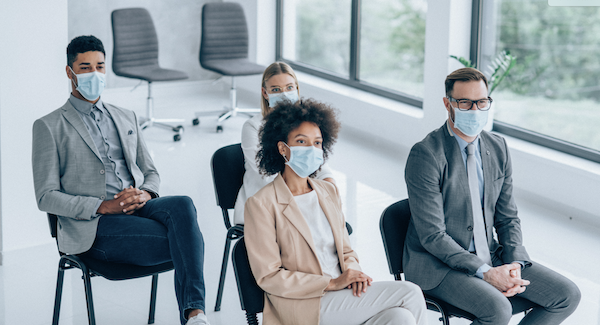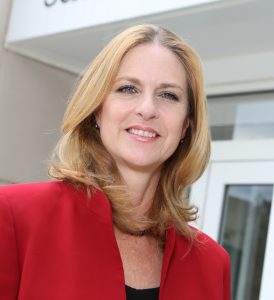MeetingMentor Magazine
What the CDC’s New “Mask Back Up” Guidance Means for Meetings and Events
 It feels like one step forward keeps leading to at least one step back when it comes to the coronavirus. The Centers for Disease Control and Prevention just in May said vaccinated people no longer have to wear masks. Then on July 27 they reversed that guidance and now recommend that even people who are fully vaccinated should wear a face covering in public indoor settings when they are in areas that have high transmission levels of COVID-19.
It feels like one step forward keeps leading to at least one step back when it comes to the coronavirus. The Centers for Disease Control and Prevention just in May said vaccinated people no longer have to wear masks. Then on July 27 they reversed that guidance and now recommend that even people who are fully vaccinated should wear a face covering in public indoor settings when they are in areas that have high transmission levels of COVID-19.
Why bring back the masking guidance now? The change was necessary, the CDC said, because both unvaccinated and vaccinated people infected with the Delta variant have 1,000 times more virus in their respiratory tracts when they test positive for COVID-19 than with any other COVID-19 variant, and 80% of the U.S. population lives in a county with high transmission. As of this writing, three out of every five counties are reporting high transmission — that is, 10 or more people being infected and testing positive per 10,000 people in the last seven days. It has been estimated that in the last week of July 1 million people a day were being infected by SARS-CoV-2; the Delta variant accounts for 93% of new infections in the U.S. According to Dr. Gavin Macgregor-Skinner, Senior Director, GBAC – Global Biorisk Advisory Council and Associate Professor, Penn State College of Medicine, while CDC data indicates that vaccinated individuals are well protected against severe illness or death, they still can pass it on, especially to those who are not yet vaccinated. Prior studies have shown that wearing a simple cloth mask during flu season could cut transmission of flu by 50%. While the CDC has not yet been able to pin down what this number is for COVID-19, it estimates that mask efficacy in preventing spread is in the 40-60% range.
So how seriously should meeting professionals take this latest guidance? Very seriously, said Roger Dow, President and CEO of the U.S. Travel Association. “The last thing we want is a backslide in the nascent recovery of travel, particularly as business travel slowly begins to rebuild,” he said. However, he added, “The updated CDC guidance should not hamper the progress made by our country in recent months as we have begun to travel and gather in-person again.”
To find out more about the update and its potential effects on meetings and events, MM tapped into the expertise of Patty Olinger, Executive Director of the Global Biorisk Advisory Council (GBAC), a division of worldwide cleaning industry association ISSA that in May 2020 launched its GBAC Star accreditation for outbreak prevention, response and recovery at venues serving the public.
MM: What do meeting professionals need to know about this new guidance from the CDC and the current state of the virus in the U.S.?

Patty Olinger, Executive Director of the Global Biorisk Advisory Council (GBAC)
Olinger: The goal is to reach herd immunity, which would mean 70% to 80% of the population are fully vaccinated, and, at just under 50%, we are not there yet. While it’s easy to Monday-morning quarterback, in retrospect, the CDC may have relaxed its guidance too soon this spring.
It’s really a numbers game. Let’s say I have a 1,000-person convention whose attendees reflect the U.S. as a whole, so 50% are vaccinated and 50% are not. So we have 500 or so people who are very vulnerable to infection and serious illness at our convention, and they can infect others when they go back to their offices and families. And even those 500 who are vaccinated can get breakthrough infections and consequently infect others, though the incidence of that is very low. We do not have herd immunity yet.
Also, while COVID is mainly an airborne-spread disease, there is a percentage — we still don’t know ether that’s 1%, 5% or 20% — that can be transmitted when we touch a contaminated surface, then touch our eyes, nose or mouth. So it’s really important to continue to be vigilant with sanitation and disinfection protocols for high-touch points in public venues, as well as get a vaccine and wear a mask and socially distance when appropriate.
We live in an extremely mobile society, especially now when there is so much pent-up demand for travel. While it’s important to stay aware of the high-transmission-rate areas, also be aware that these numbers can change dramatically from day to day. [Planners can keep a watch on their host destinations on a regularly updated map that outlines those areas, which currently include two-thirds of all U.S. counties, on the CDC website.]
MM: If the local/regional guidance does not recommend or even prohibits indoor masking at this time, what would you recommend meeting and event organizers should do when developing their policies?
Olinger: I’ve have been an advocate from the beginning, even before the vaccine, that we can safely hold meetings and events as long as we follow certain practices and protocols. Attendees may not want to have wear masks again, but if that’s what it takes for us to stay open and hold events, that’s what we’ll have to do, along with some simple practices such as having hand sanitizer available throughout the facility.
Everyone needs to pay close attention to their local guidance and recommendations as well as those from the CDC — and from their host venues. For example, Broadway theaters have recently announced that they will require face masks and proof of vaccination or a negative COVID test for audience members until at least the end of October. It wouldn’t surprise me if we started to see that in meetings and events venues as well.
What we don’t want is for people to be able to point to the event as where they contracted the virus. We need to put in place systems and procedures that reduce the likelihood of that transmission. No, we can’t control what people do outside of the venue, but we want to be able to ensure that nothing happens that will shut down meetings and events.
During this transition period it’s really important that event organizers, the facility, the service providers and the people who attend all work together so we can continue moving forward.
And I would encourage everyone to get vaccinated. That’ll help us get back to normal sooner than later.
Free Subscription to
MeetingMentor Online
"*" indicates required fields
About ConferenceDirect
About MeetingMentor